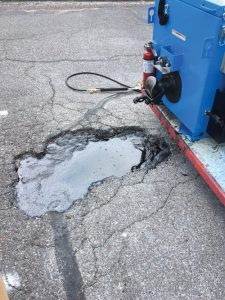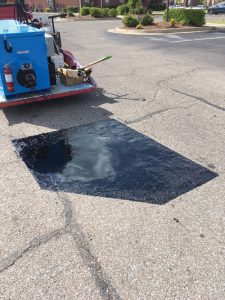— By Lee Lowis —
Durable parking lot repairs with less downtime.
Henry Ford did not invent the automobile, nor did he invent the assembly line. His efforts did bring the horseless carriage within reach of the middle class. Similarly, neither Microsoft nor Apple invented the computer. They saw an opportunity to take computer technology and make it available and useful to everyone. These are just two examples of ingenuity making a difference.
Innovative Technology for Your Parking Lots

Lee Lowis, GemSeal Pavement Products
How could your retail store or restaurant benefit from a similar situation? A product invented in the 1890s, and successfully used by DOTs and turnpike authorities since the 1970s, is now readily available to provide quick, long-term asphalt and concrete repairs on retail and restaurant parking lots nationwide.
The material is called mastic, a hot-applied compound used for the partial or full-depth repair of asphalt and concrete pavements. It can be either highly modified asphalt binder (black) for asphalt repair or resin (gray) with aggregates that provide long-lasting repairs and years of performance to distressed pavements, spalled concrete, utility cuts and a multitude of other pavement repairs.
For many years the use of mastic material was almost exclusive to highways, turnpikes and bridges. This is because the application equipment was large, expensive and generally not available to commercial paving contractors. Also, much of the material had to be mixed on the job site.
Recent improvements in packaging have made it possible for contractors to purchase materials premixed. Moreover, the advent of smaller, compact equipment has opened the market to commercial paving contractors performing parking lot maintenance.
Advantages for Your Pavement Assets
 This proven technology provides many advantages over traditional repairs in both asphalt and concrete. Both types of material are ideal for full-depth repairs. Either variety can be used to repair stress cracks, utility cuts, manholes, potholes and spalled concrete. Mastic material can also be used as a waterproofing or surface treatment. Installation requires no compaction, and the treated area can be opened to traffic as soon as the material cools, often within 1 hour. The biggest benefit is that the repair is quick, which means minimal downtime to your busy retail or restaurant facility.
This proven technology provides many advantages over traditional repairs in both asphalt and concrete. Both types of material are ideal for full-depth repairs. Either variety can be used to repair stress cracks, utility cuts, manholes, potholes and spalled concrete. Mastic material can also be used as a waterproofing or surface treatment. Installation requires no compaction, and the treated area can be opened to traffic as soon as the material cools, often within 1 hour. The biggest benefit is that the repair is quick, which means minimal downtime to your busy retail or restaurant facility.
Application Benefits
Traditional concrete repairs require saw cutting and removal of the affected area. With hot-applied gray mastic, spalled areas are repaired without excavation. The surface area is swept clean, a light primer is applied, then the mastic is poured on the damaged area. With little effort the application is leveled. As quickly as the material is cooled, the repair is reopened. The repair can support full load-bearing traffic or can be used for a simple break in a sidewalk. It’s no longer necessary to wait 2 or 3 days before reopening your parking lot after a full-depth concrete repair. In Oklahoma, the turnpike authority has been using gray mastic for years, reducing the time that lanes need to be closed and greatly reducing the need for saw cutting and hauling broken concrete off of the site.
 Asphalt repairs are just as impressive. Black mastic can be used for nearly any type of asphalt repair. A few uses include as a thin overlay, a full-depth repair (a great solution for alligatored pavement), to fill wide cuts in the asphalt that traditional crack fillers cannot handle, and to fill low areas. Like gray, no compaction is necessary, and the repair is ready for load-bearing traffic as quickly as it cools.
Asphalt repairs are just as impressive. Black mastic can be used for nearly any type of asphalt repair. A few uses include as a thin overlay, a full-depth repair (a great solution for alligatored pavement), to fill wide cuts in the asphalt that traditional crack fillers cannot handle, and to fill low areas. Like gray, no compaction is necessary, and the repair is ready for load-bearing traffic as quickly as it cools.
Why Specify Mastic Material?
Why would you ask your parking lot maintenance contractor to use mastic material over conventional repair and replace methods? Ask yourself, how long are your repairs lasting? Are you getting 5, 10 or more years from asphalt and concrete repairs? In many areas, asphalt and concrete repairs completed with mastic material last over ten years. If you are paying to route or mill rough or cracked areas, consider fixing those problems with mastic material, which is longer lasting and more durable. Plus, you get the added benefit of a high friction, finished surface that provides an element of safety for foot and vehicular traffic.
Who Can Apply Mastic Material?
Mastic material is readily available to commercial paving contractors in the U.S. and Canada from several suppliers. Unfortunately, not all asphalt and concrete contractors are familiar with the material because the perception has been that it is exclusively for highway use. The good news is that any manufacturer of mastic material is more than willing to train contractors on the product, equipment, and most importantly — the proper method to install mastic material. Be sure to qualify your contractor by discussing his or her experience with the material.
It may seem that this repair method is too good to be true. However, the truth is that mastic material has been used successfully for decades by DOTs across the U.S., Canada and Europe. Because of its flexible properties, mastic material performs as well in hot climates as in the bitter cold. And, thanks to innovative packaging and advancements in equipment, mastic material is now available to commercial paving contractors for use in off-street repairs. Ask your preferred parking lot maintenance contractor about mastic material and experience the benefits to your pavement assets and bottom line.
— Lee F. Lowis, president of GemSeal Pavement Products, has been in the pavement maintenance industry for over 40 years. He leverages his broad depth of knowledge and experience in the industry to lead and grow the company, which has provided contractors and property managers with solutions to pavement problems for over 60 years.
